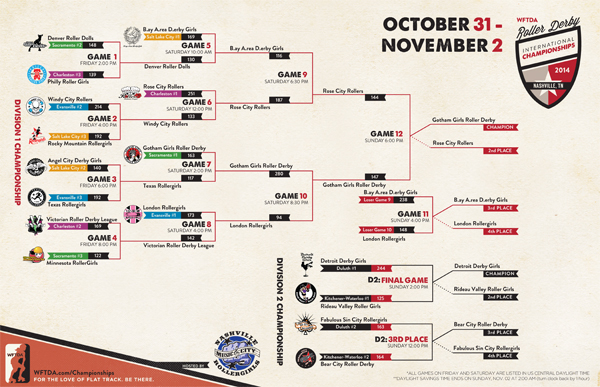| WFTDA 2014 D1 & D2 | Playoffs & Championships |
Welcome to WFTDA Tournament Central 2014!
Gotham Girls Roller Derby Win the 2014 WFTDA Championships!

Photo by Donna Olmstead
Gotham Girls Roller Derby defeated Rose City Rollers to become the 2014 WFTDA Champions for the fourth year in a row, and fifth time over all. Bay Area Derby Girls came in third place. Detroit Derby Girls won the Division 2 Championship, with Rideau Valley Roller Girls coming in second, and Bear City Roller Derby placing third.
Championships Bracket
About WFTDA Playoffs and Championships
In 2006, the first flat track roller derby championship was Dust Devil, held in Tucson, AZ. Dust Devil kicked off with a round robin for seeding purposes, because at the time the teams had never competed tournament-style and had no national ranking method. In 2007, WFTDA saw competing leagues split into Eastern and Western playoffs, culminating in a Championship tournament in Austin, TX. Portland, OR's turn at hosting Championships in 2008 included the first unveiling of The Hydra, the championship trophy earned by the winner each year since. In 2009, competition subdivided into four geographic regions - East and West were joined by North Central and South Central. WFTDA played out those same regional playoffs in 2010, but it wasn't until 2011 that we first saw a league outside of North America qualify for the playoffs, with London Rollergirls attending East Region Playoffs. London was also the first non-US team to compete in a WFTDA Championship tournament in 2013, making WFTDA tournaments a truly worldwide endeavor.
In 2013, WFTDA reached another milestone in that the geography-based Region Playoffs were replaced with four Division I Playoffs and two Division 2 Playoffs. Teams must meet regular season game play requirements to be eligible for Playoffs.
About S-Curve Seeding
D1 Playoffs are seeded using an S-shaped seeding model with strict competitive parity. An S-curve seeding structure provides for an even distribution of top seeds at each tournament. This means the #1, #2, #3, and #4 ranked leagues each go to a different tournament, and each subsequent seed is distributed across tournaments following an S-shaped pattern, until all of the top 40 teams are assigned. There is no shuffling or deviation from the seeding based on geographic location. D2 tournaments follow the same structure, with the next 20 teams distributed across two tournaments.
Real. Strong. Athletic. Revolutionary.

